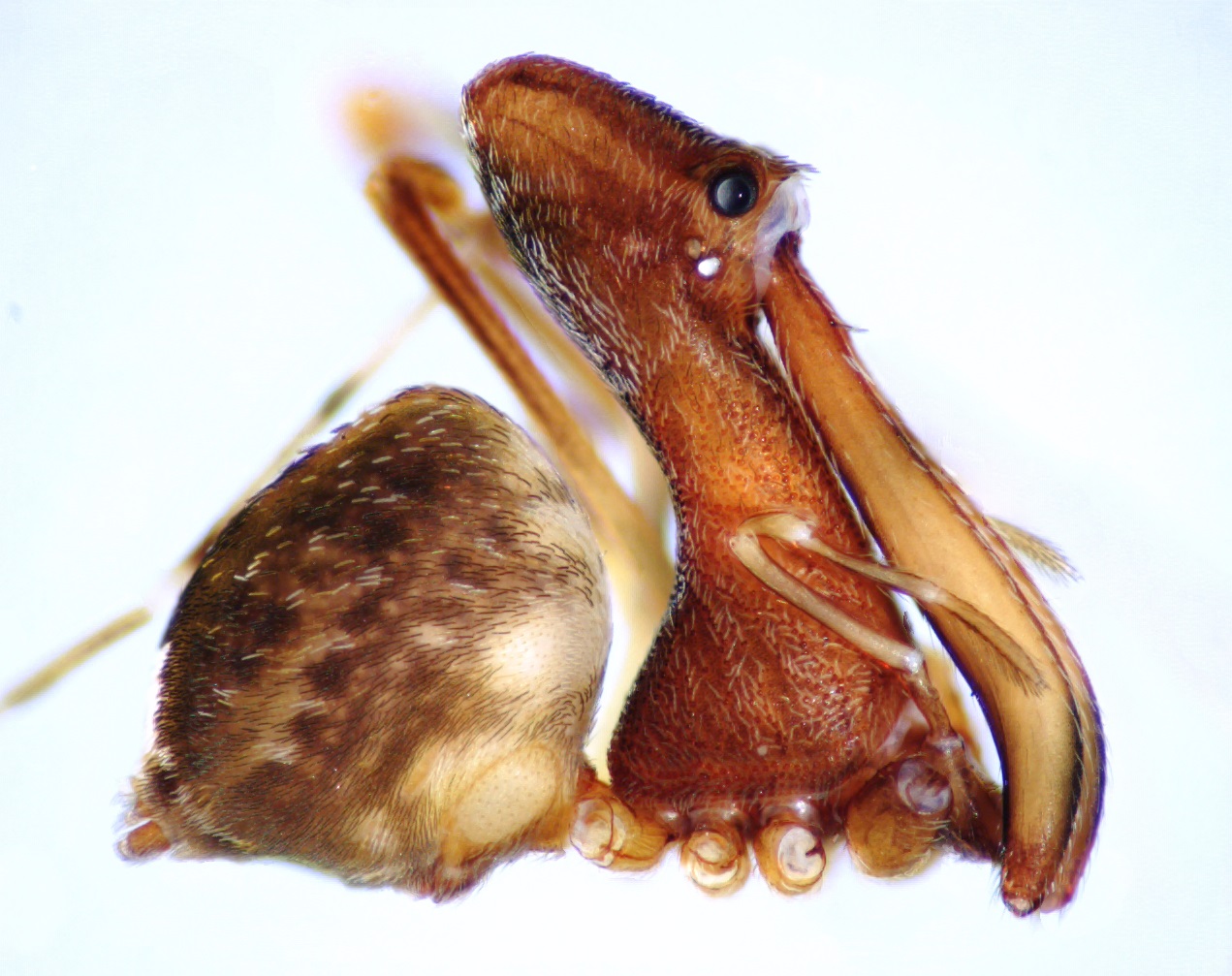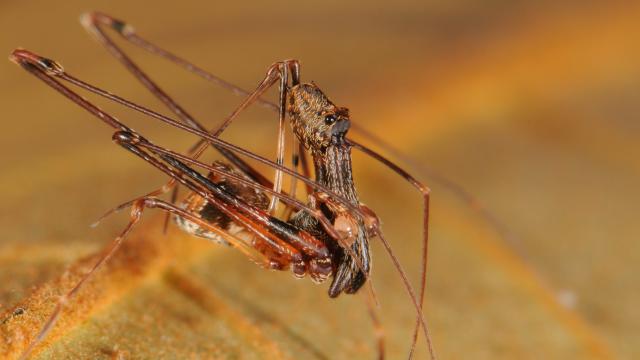Quick: what has eight legs and a face like a pair of hairy salad tongs? If you’re a spider, you know exactly what I’m describing – a beast, which, at least to smaller spiders, is an otherworldly, eldritch terror: the pelican spider. Now, new research published today in the journal ZooKeys details the discovery of a whopping 18 new species of pelican spider from Madagascar.
At first glance, pelican spiders (family Archaeidae) aren’t exactly horrifying, just really damn doofy looking. They get their birdy name from the unsettling funhouse warping of their “head” segment (known as the cephalothorax), which has been stretched dramatically upwards, making it appear as though the spider has a long “neck.” This, combined with its mouthparts – which are lengthened into folding, salad tong-like abominations – give the spider a profile that evokes the gawkiness of a pelican. In reality, there is no “neck”; it’s more like the head was pulled at its midline like a piece of taffy.
But it’s not the pelican spider’s twisted visage that makes it a recurrent, grave addition to campfire stories at spiderling summer camp – it’s what those bizarre features evolved to do. Pelican spiders are also called “assassin spiders” because their diet consists entirely of other spiders, which they slowly stalk and devour. These specialised hunters have abandoned the idea of webs altogether, instead hunting by prodding along the forest with a pair of thin, sensitive, antennae-like legs, like an arachnid Slenderman. Once they strike silk, they ever-so-carefully lure out the web’s owner with a strategic pluck or two, then swiftly dispatch the victim with those long, rotating jaws, each tipped with a venomous fang. The pelican spider then keeps its prey pinned at the end of its death-tweezers, rendering any retaliation impotent, until the venom does its thing.

This pelican spider dangles its spider prey upside-down using its chelicerae (mouthparts) after capturing it. Credit: Nikolaj Scharff
This strange family of spiders caught the attention of Hannah Wood, curator of arachnids and myriapods (millipedes and their relatives) at the Smithsonian Museum of Natural History and lead author on the new study. For years, the evolution and biodiversity of pelican spiders has been her primary research focus, one that has ultimately led to this discovery.
“I was curious to understand why these strange-looking spiders looked the way they did,” Wood told Gizmodo, “and furthermore, why there was so much variation in the way they looked.”
Madagascar was the perfect place to ask such questions. Today, pelican spiders are only found in Madagascar, South Africa, and Australia – distributed across the old southern supercontinent of Gondwana, which broke up over 100 million years ago (some fossils date back to 165 million years). The pelican spider is both a “living fossil” and a “Lazarus taxon” (an organism that gives the appearance of being resurrected from prehistory because its fossils were found before living versions). Madagascar sits at the heart of the pelican spider’s ancestral origins, and Wood and study coauthor Nikolaj Scharff think it’s likely that the spiders have had a dynamic evolutionary history in isolation.
“We think that ancient geological and climatic events on Madagascar led to a build-up of species in certain areas, and this may have caused their traits to diversify to reduce competition among close relatives,” Wood explains.

Eriauchenius milajaneae (pictured above) is one of the 18 new species of pelican spiders from Madagascar described by the scientists. Credit: Hannah Wood, Smithsonian
Wood examined collections from expeditions to the island and her own fieldwork, making detailed measurements and observations of their physical and ecological characteristics, trying to piece together their interrelationships and their place in the local environment. In doing so, Wood was able to define 26 species from the island – 18 of which had never been described before.
The discovery drives home just how much native biodiversity may remain undiscovered in Madagascar. The island is renowned for being a laboratory of evolution, with many of its inhabitants – from lemurs, to Mantella poison frogs, to carnivorous fossas – found nowhere else on Earth. Tragically, a great many of these unique species are threatened with extinction from habitat loss or from over-exploitation. The current biodiversity crisis in the region threatens to even extinguish species not yet known to science, those perhaps much like the new contingent of pelican spiders.
